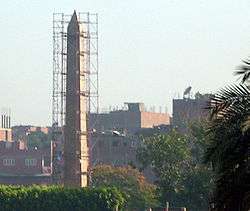El Matareya, Cairo
Mataria (Arabic: المطرية pronounced [el.mɑ.tˤɑ.ˈɾej.jɑ]) is a district in the northern region of Greater Cairo, east of the Nile, in Egypt. The district is unrelated to the coastal town in the Dakahlia Governorate, that is also named El Matareya. The district's location was part of the ancient city of Heliopolis, one of the oldest cities of ancient Egypt.
Name
The name, Mataria, (30° 7'46.08"N 31°18'26.94"E) is thought to come from the Latin word Mater which means 'mother', and is from the presence of the 'tree of the Virgin Mary' in this district.
History
Mataria, with the nearby Ain Shams district, had a notable history during Egypt's Pharaonic period as a part of ancient Heliopolis. The district has archaeological sites of the period, some only recently discovered, beneath its current structures.[1] In ancient Roman times Heliopolis belonged to the Augustamnica province. Legend tells of the Christian Holy Family sheltering under a tree in Heliopolis, presently known as 'the tree of the Virgin Mary',[2] now with the Chapel of the Virgin in Mataria.[3]
The French naturalist Pierre Belon du Mans mentions visiting Mataria in his 1547 journey to Egypt.[4] Mataria once had the villas of prominent people. The famous Egyptian poet Ahmed Shawqi lived in a villa he named ‘Karmet Ibn Hani’ or Ibn Hani’s Vineyard كرمة ابن هانىء here, near the palace of the Khedive Abbas II at Saray El-Qobba, until his exile from Egypt at World War I.[5]
Historic elements

The El Masalla area of the district contains the ancient Masalla Obelisk, or Misalla (Arabic: المسلة, trans. obelisk), one of the Pharaonic era obelisks that still remain in Egypt.[6] It is the only surviving element of Heliopolis standing in its original position, and of the great Temple of Re—Atum constructed by Pharaoh Senusret I (1971 BCE—1926 BCE) of the Twelfth Dynasty.[7] The 68 ft (20.73 m) tall red granite obelisk weighs 120 tons—240,000 pounds (110,000 kg).
A pink granite megalithic colossus statue, with features resembling those of the Pharaoh Ramesses II, was found in El Matareya in 2006, weighing five tons—11,023 pounds (5,000 kg). It was at the ruins of a sun temple dating back to the reign of Ramses II (reigned 1279 BCE—1213 BCE), at the site of later Souk El-Khamis.
The underground tombs of High Priests of Re of the Sixth Dynasty (2345 BCE—2181 BCE) were found in the southeast corner of the Re-Atum Temple archaeological site in El Matareya.[8] The Necropolis of Heliopolis, 3 miles (4.8 km) east of the Masalla obelisk in El Matareya, dates from the Middle Kingdom (c. 2055 BCE—1550 BCE) and New Kingdom (c. 1550 BCE—1069 BCE).[9] A domed tomb made for a priest during the Twenty-sixth Dynasty (c. 685 BCE—525 BCE), was discovered under a construction site in 2004. Many funereal small figure statues were found inside (over 400), and hieroglyphic writing was on the tomb's walls from the 7th century BCE.[1]
In the incoherent district of El-Mataria, in Cairo, there stands an old sycamore tree that has been attracting thousands of pilgrims each Christmas, it's called the "Virgin's Tree". There are many sacred trees in Egypt, trees that have offered shelter for the Holy Family during their stay here, but the one in Mataria holds the highest regard of all.
Education
- Desert Research Center, established by Laszlo Almasy.
- Faculty of Engineering, Helwan University
- National Urology Institute of Egypt
- Mataria Teaching Hospital
Industry
The western part of Mataria, within the industrial area of Musturud along the Ismailia canal, is the location of oil companies (Shell, Misr Petrol, and General Association of Oil in Egypt), and food industries (“Bisco Misr” and “Misr lil Albaan”).[10]
See also
- Ancient Heliopolis
- Modern Heliopolis
- Heliopolis style - architecture
- El Matareya - a town in Dakahlia governorate.
References
- Descubrimientos - Egipto - Junio / Diciembre 2004; "Pharonic tomb uncovered in Cairo, suburbs of Matareya"; August 26, 2004 . accessed 1.28.2011
- "Holy Family in Egypt". 2002-03-24. Archived from the original on 2002-03-24. Retrieved 2018-02-26.
- "15 Top Tourist Attractions in Cairo & Easy Day Trips - PlanetWare".
- Culture musulmane en Égypte (Suite) Archived 2008-09-12 at the Wayback Machine Page 6. (in French)
- "My Father Shawky" by Hussin Ahmed Shawky; 2nd edition, 2006 Cairo; (in Arabic)
- "15 Top Tourist Attractions in Cairo & Easy Day Trips - PlanetWare".
- "OBELISK (Gr. b/3EXivrc... - Online Information article about OBELISK (Gr. b/3EXivrc..." encyclopedia.jrank.org.
- "Archived copy". Archived from the original on 2010-12-23. Retrieved 2011-01-30.CS1 maint: archived copy as title (link)
- "15 Top Tourist Attractions in Cairo & Easy Day Trips - PlanetWare".
- "Said Samir". Said Samir.